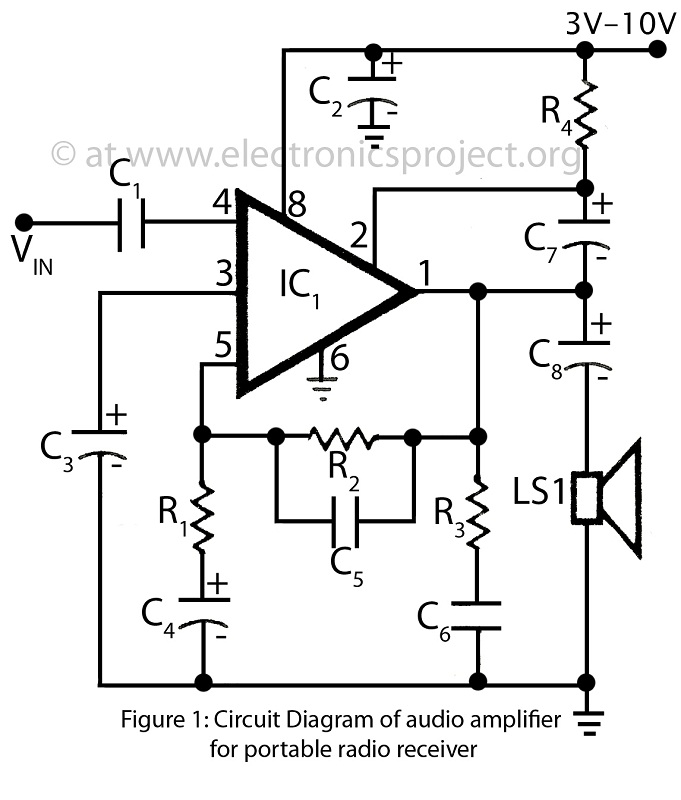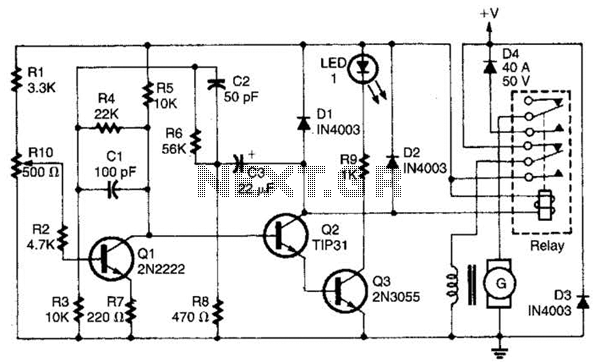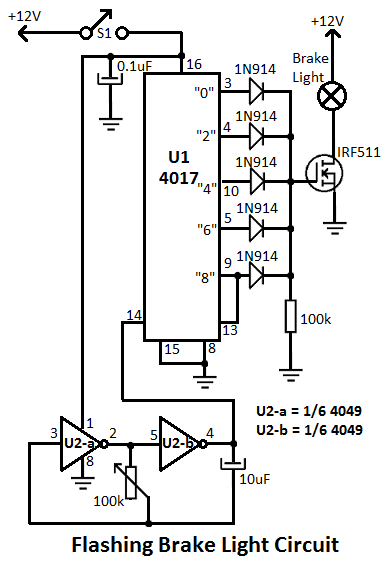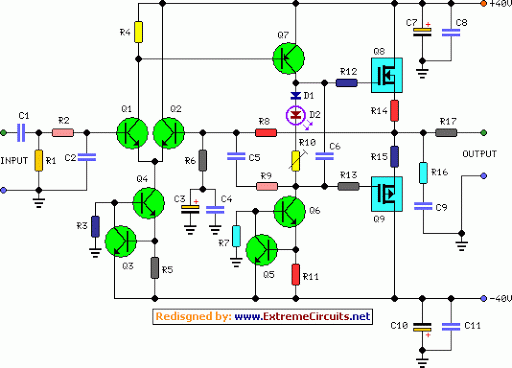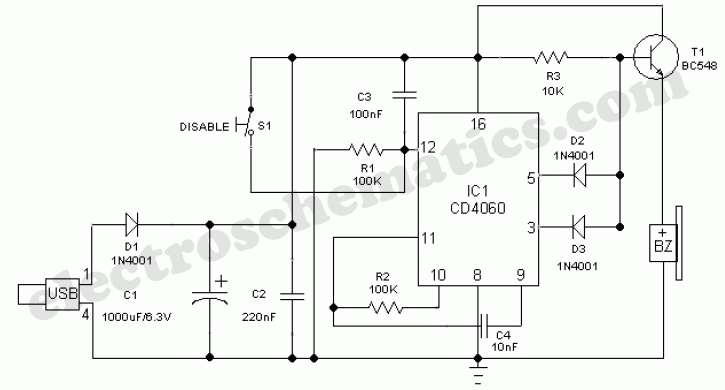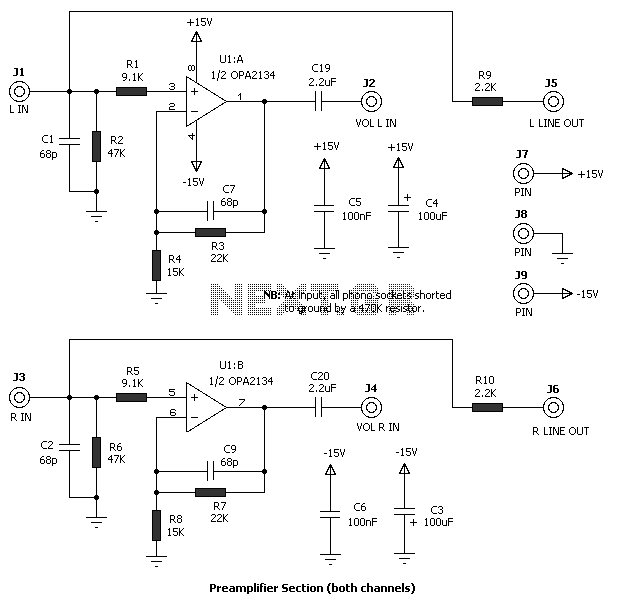
IP phone to analog phone or modem audio interface circuit
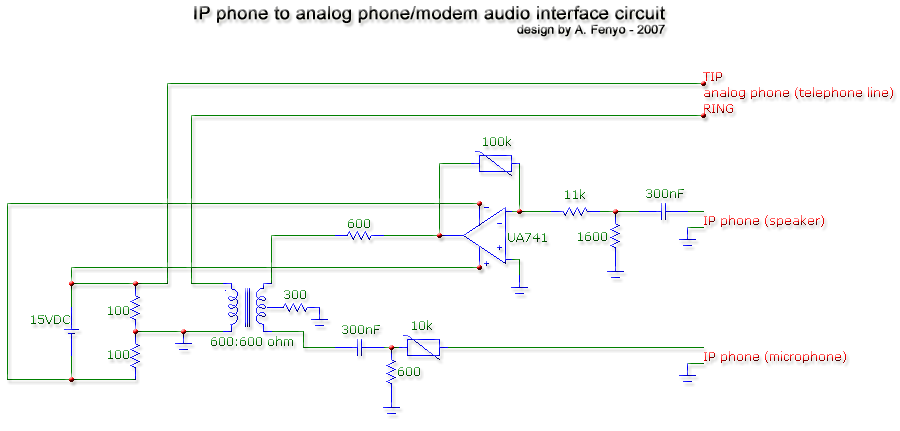
The transformer is a 600:600 ohm transformer, also referred to as a 1:1 ratio 600 ohm transformer. It has approximately the same number of turns on both the primary and secondary coils and is optimized for operation at a 600 ohm load. Selectronic offers this transformer. Measurements taken from the Selectronic unit indicate that the primary and secondary coils have an inductance of about 75 mH and a resistance of approximately 50 ohms. The variable resistors must be finely tuned for optimal impedance matching with the IP phone. The resistor near the IP phone speaker will likely need to be set to a high value (around 10K ohms) as it directly influences the amplification of the audible signal. Conversely, the other resistor should be set to a low value, as it is intended to attenuate the signal level sent to the IP phone, compensating for the lower output from the replaced microphone. Two 100 ohm resistors will dissipate approximately 600 mW each; therefore, it is advisable to avoid using standard low-cost half-watt resistors or to opt for 150 ohm standard resistors instead. Additionally, two 300 nF capacitors and their corresponding resistors function as high-pass first-order filters, with a cutoff frequency around 300 Hz, to eliminate noise and facilitate echo cancellation. During the design of this telephone interface circuit, a Sound Blaster Extigy sound card from Creative Labs was utilized as a function generator. Some unusual effects were observed, leading to the realization that the headphone output exhibited a suboptimal transfer function. The voltage transfer function was plotted using an APPA 106 multimeter, revealing characteristics of a Head Relative Transfer Function (HRTF).
The circuit utilizes a 600:600 ohm transformer, which serves as an impedance-matching device between the IP phone and the associated audio components. The transformer’s design, with equal turns on both coils, ensures minimal signal loss and optimal performance at the specified load impedance. The inductance of 75 mH suggests that the transformer can handle a range of audio frequencies effectively, making it suitable for voice transmission.
Variable resistors are employed to fine-tune the impedance match. The resistor near the speaker is critical for adjusting the amplification of the audio output, which is essential for achieving clear sound quality. The high-value resistor, set at approximately 10K ohms, allows for greater control over the signal amplification. The second variable resistor, designed to operate at a lower value, is crucial for managing the input signal from the microphone, ensuring that the output level is appropriate for the IP phone's input specifications.
The inclusion of two 100 ohm resistors, each dissipating around 600 mW, necessitates careful selection to prevent overheating. Using resistors rated for higher power dissipation, such as 150 ohms, can enhance reliability and performance.
The circuit also incorporates two 300 nF capacitors in conjunction with their associated resistors, forming high-pass filters that effectively mitigate low-frequency noise and assist in echo cancellation. The cutoff frequency of approximately 300 Hz is strategically chosen to filter out unwanted low-frequency signals, thereby enhancing the clarity of voice transmission.
The observations made during the testing phase, particularly regarding the headphone output and its transfer function, highlight the importance of understanding the acoustic characteristics of audio devices. The identification of the Head Relative Transfer Function (HRTF) emphasizes the need for precise calibration in audio applications, particularly in environments where spatial audio perception is critical.
Overall, this circuit design provides a robust solution for interfacing an IP phone with audio components, ensuring optimal performance through careful impedance matching, filtering, and signal amplification techniques.The transformer is a 600:600 ohms transformer (also named 1:1 ratio 600 ohm transformer) : more or less the same number of turns on both primary and secondary coils, and optimized to work at 600 ohms load. Selectronic sells one here. I measured the primary and secondary coils on the one from Selectronic: about 75 mH inductance and 50 ohms
resistance. - the variable resistors need to be fine tuned for operating at best impedance match with the IP phone. The one near the IP phone speaker will probably need to be tuned at a high value (about 10K ohms); it directly controls the amplification of the signal you ear.
The other needs to be very low since it is only here to attenuate the level at which your voice is sent to the IP phone, since the microphone you replaced with this module probably sends a lower signal than this module. - the two 100 ohms resistors will dissipate about 600 mW each : avoid using those standard low-cost half watt resistors (or use 150 ohms standard ones instead.
). - the two 300 nF capacitors (and their associated resistors) act as high-pass first order filters (Fc is about 300 Hz) to eliminate noise and perform echo cancellation. While I was conceiving this telephone interface circuit, I used my Sound Blaster Extigy sound card from Creative Labs as a function generator.
I encountered weird effects and I realized the headphones output had a not so good transfer function. I plotted the voltage transfer function with my APPA 106 multimeter. Here it is: After weeks having bad dreams about this weird transfer function, I suddenly realized, one night, that it was obviously a Head Relative Transfer Function (HRTF) !
Here is a plot of a standard HRTF (extracted from this web site ): 🔗 External reference
The circuit utilizes a 600:600 ohm transformer, which serves as an impedance-matching device between the IP phone and the associated audio components. The transformer’s design, with equal turns on both coils, ensures minimal signal loss and optimal performance at the specified load impedance. The inductance of 75 mH suggests that the transformer can handle a range of audio frequencies effectively, making it suitable for voice transmission.
Variable resistors are employed to fine-tune the impedance match. The resistor near the speaker is critical for adjusting the amplification of the audio output, which is essential for achieving clear sound quality. The high-value resistor, set at approximately 10K ohms, allows for greater control over the signal amplification. The second variable resistor, designed to operate at a lower value, is crucial for managing the input signal from the microphone, ensuring that the output level is appropriate for the IP phone's input specifications.
The inclusion of two 100 ohm resistors, each dissipating around 600 mW, necessitates careful selection to prevent overheating. Using resistors rated for higher power dissipation, such as 150 ohms, can enhance reliability and performance.
The circuit also incorporates two 300 nF capacitors in conjunction with their associated resistors, forming high-pass filters that effectively mitigate low-frequency noise and assist in echo cancellation. The cutoff frequency of approximately 300 Hz is strategically chosen to filter out unwanted low-frequency signals, thereby enhancing the clarity of voice transmission.
The observations made during the testing phase, particularly regarding the headphone output and its transfer function, highlight the importance of understanding the acoustic characteristics of audio devices. The identification of the Head Relative Transfer Function (HRTF) emphasizes the need for precise calibration in audio applications, particularly in environments where spatial audio perception is critical.
Overall, this circuit design provides a robust solution for interfacing an IP phone with audio components, ensuring optimal performance through careful impedance matching, filtering, and signal amplification techniques.The transformer is a 600:600 ohms transformer (also named 1:1 ratio 600 ohm transformer) : more or less the same number of turns on both primary and secondary coils, and optimized to work at 600 ohms load. Selectronic sells one here. I measured the primary and secondary coils on the one from Selectronic: about 75 mH inductance and 50 ohms
resistance. - the variable resistors need to be fine tuned for operating at best impedance match with the IP phone. The one near the IP phone speaker will probably need to be tuned at a high value (about 10K ohms); it directly controls the amplification of the signal you ear.
The other needs to be very low since it is only here to attenuate the level at which your voice is sent to the IP phone, since the microphone you replaced with this module probably sends a lower signal than this module. - the two 100 ohms resistors will dissipate about 600 mW each : avoid using those standard low-cost half watt resistors (or use 150 ohms standard ones instead.
). - the two 300 nF capacitors (and their associated resistors) act as high-pass first order filters (Fc is about 300 Hz) to eliminate noise and perform echo cancellation. While I was conceiving this telephone interface circuit, I used my Sound Blaster Extigy sound card from Creative Labs as a function generator.
I encountered weird effects and I realized the headphones output had a not so good transfer function. I plotted the voltage transfer function with my APPA 106 multimeter. Here it is: After weeks having bad dreams about this weird transfer function, I suddenly realized, one night, that it was obviously a Head Relative Transfer Function (HRTF) !
Here is a plot of a standard HRTF (extracted from this web site ): 🔗 External reference
